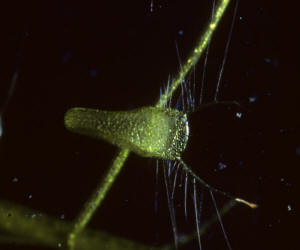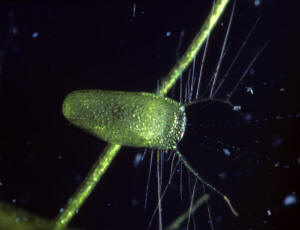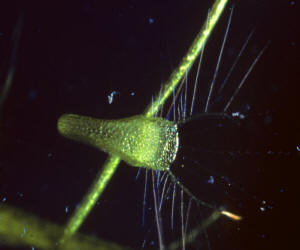|
Carnivorous Plants Story
|
||
|
|
In nature, as well as in cultivation, flies, ants, and
spiders are a typical meal for the Venus flytrap. A nectar
band just below the marginal spines creates an irresistible lure for the
potential prey. Because of the stiff spines around the lobe, it ed to
position itself between the trap lobes. Three pairs of innocuous-looking
bristles grow on the inner surface of the lobes. The visitor to the Venus' diner
has no way of knowing what will precipitate if these sensitive hairs are
disturbed. is
impossible to lick the nectar from outside.
the Venus flytrap. A nectar band just below the marginal spines creates an irresistible lure for the potential prey. Because of the stiff spines around the lobe, it ed to position itself between the trap lobes. Three pairs of innocuous-looking bristles grow on the inner surface of the lobes. The visitor to the Ve the Venus flytrap. A nectar band just below the marginal spines creates an irresistible lure for the potential prey. Because of the stiff spines around the lobe, it ed to position itself between the trap lobes. Three pairs of innocuous-looking bristles grow on the inner surface of the lobes. The visitor to the Ve the Venus flytrap. A nectar band just below the marginal spines creates an irresistible lure for the potential prey. Because of the stiff spines around the lobe, it ed to position itself between the trap the Venus flytrap. A nectar band just below the marginal spines creates an irresistible lure for the potential prey. Because of the stiff spines around the lobe, it ed to position itself between the trap lobes. Three pairs of innocuous-looking bristles grow on the inner surface of the lobes. The visitor to the Ve
the Venus flytrap. A nectar
band just below the marginal spines creates an irresistible lure for the
potential prey. Because of the stiff spines around the lobe, it ed to
position itself between the trap lobes. Three pairs of innocuous-looking
bristles grow on the inner surface of the lobes. The visitor to the Ve lobes. Three pairs of innocuous-looking bristles grow on the inner surface of the lobes. The visitor to the Ve s, and spiders are a typical meal for the Venus flytrap. A nectar band just below the marginal spines creates an irresistible lure for the potential prey. Because of the stiff spines around the lobe, it ed to position itself between the trap lobes. Three pairs of innocuous-looking bristles grow on the inner surface of the lobes. The visitor to the Ves, and spiders are a typical meal for the Venus flytrap. A nectar band just below the marginal spines creates an irresistible lure for the potential prey. Because of the stiff spines around the lobe, it ed to position itself between the trap lobes. Three pairs of innocuous-looking bristles grow on the inner surface of the lobes. The visitor to the Ve
s, and spiders are a typical meal for the Venus flytrap.
A nectar
band just below the marginal spines creates an irresistible lure for the
potential prey. Because of the stiff spines around the lobe, it ed to
position itself between the trap lobes. Three pairs of innocuous-looking
bristles grow on the inner surface of the lobes. The visitor to the Ves,
and spiders are a typical meal for the Venus flytrap. A nectar
band just below the marginal spines creates an irresistible lure for the
potential prey. Because of the stiff spines around the lobe, it ed to
position itself between the trap lobes.
nts, and spiders are a typical meal for the Venus flytrap. A nectar band just below the marginal spines creates an irresistible lure for the potential prey. Because of the stiff spines around the lobe, it ed to position itself b nts, and spiders are a typical meal for the Venus flytrap. A nectar band just below the marginal spines creates an irresistible lure for the potential prey. Because of the stiff spines around the lobe, it ed to position itself b nts, and spiders are a typical meal for the Venus flytrap. A nectar band just below the marginal spines creates an irresistible lure for the potential prey. Because of the stiff spines around the lobe, it ed to position itself bers are a typical meal for the Venus flytrap. A nectar band just below the marginal spines creates an irresistible lure for the potential prey. Because of the stiff spines around the lobe, it ed to position itself b nts, and spiders are a typical meal for the Venus flytrap. A nectar band just below the marginal spines creates an irresistible lure for the potential prey. Because of the stiff spines around the lobe, it ed to position itself between the trap lobes. Three pairs of innocuous-looking bristles grow on the inner surface of the lobes. The visitor to the Ve hen the trigger hairs on the inner surface of the trap lobes are stimulated, the clam-shell-shaped trap closes suddenly --- often in less than a half second --- fast enough to capture such agile insects as a fly quite comfortably. Intermeshing marginal spines effectively prevent the prey's escape. After the initial rapid closure, the insect's stru When the trigger hairs on the inner surface of the trap lobes are stimulated, the clam-shell-shaped trap closes suddenly --- often in less than a half second --- fast enough to capture such agile insects as a fly quite comfortably. Intermeshing marginal spines effectively prevent the prey's escape. After the initial rapid closure, the insect's struggle inside the trap further stimulates the trigger hairs, causing the trap lobes to close even more tightly. In a day or so, the trap is seen tightly sealed around the free margins of the lobes, with the marginal spines pointing outwardly. The digestive fluids start to ooze into the now sealed trap cavity. As the digestive process progresses, the products of digestion are swiftly absorbed through the leaf and are carried away to the other parts of the plant.
Introduction Venus Flytrap Sundews Pitcher Plants Cobra Plant Butterworts Bladderworts
|
|


 Three pairs of innocuous-looking bristles grow on the inner surface of the
lobes. The visitor to the Ve
Three pairs of innocuous-looking bristles grow on the inner surface of the
lobes. The visitor to the Ve